Introspection in Psychology: Titchener's Findings and Mini Study
VerifiedAdded on 2023/01/06
|8
|2051
|73
AI Summary
This article explores the concept of introspection in psychology and compares Edward Bradford Titchener's findings with a mini study on hibiscus. It discusses the three basic elements of consciousness and their influence on perception, ideas, and emotions.
Contribute Materials
Your contribution can guide someone’s learning journey. Share your
documents today.
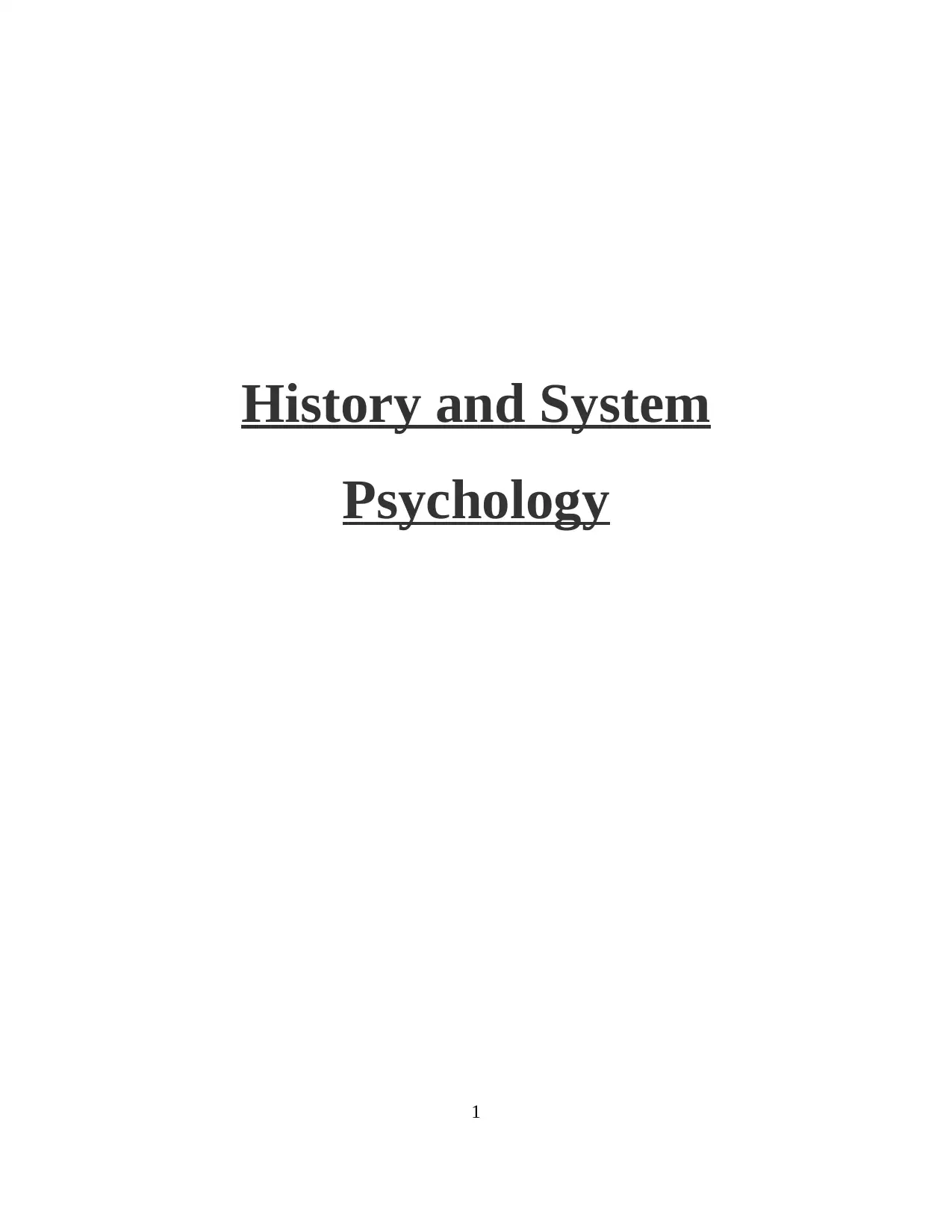
History and System
Psychology
1
Psychology
1
Secure Best Marks with AI Grader
Need help grading? Try our AI Grader for instant feedback on your assignments.
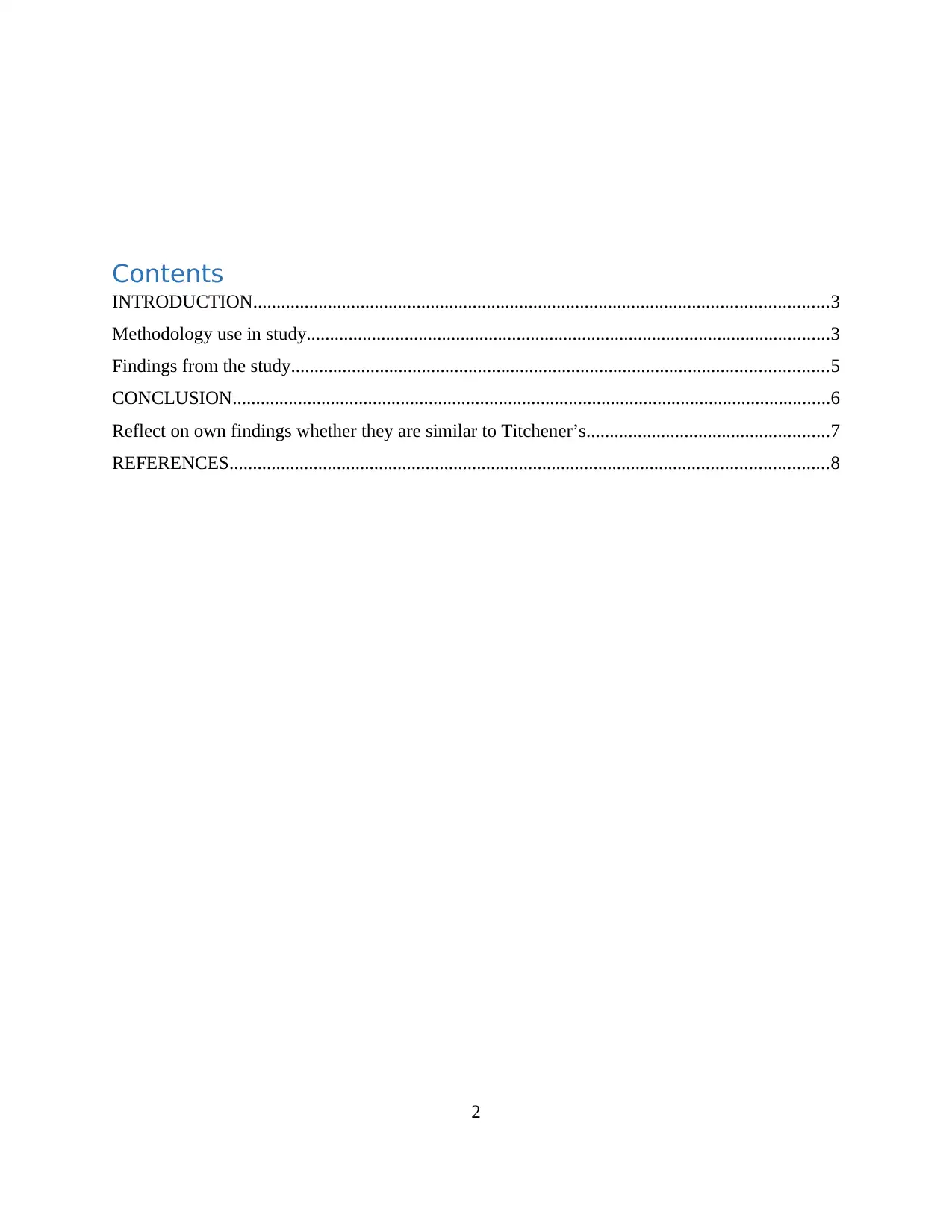
Contents
INTRODUCTION...........................................................................................................................3
Methodology use in study................................................................................................................3
Findings from the study...................................................................................................................5
CONCLUSION................................................................................................................................6
Reflect on own findings whether they are similar to Titchener’s....................................................7
REFERENCES................................................................................................................................8
2
INTRODUCTION...........................................................................................................................3
Methodology use in study................................................................................................................3
Findings from the study...................................................................................................................5
CONCLUSION................................................................................................................................6
Reflect on own findings whether they are similar to Titchener’s....................................................7
REFERENCES................................................................................................................................8
2
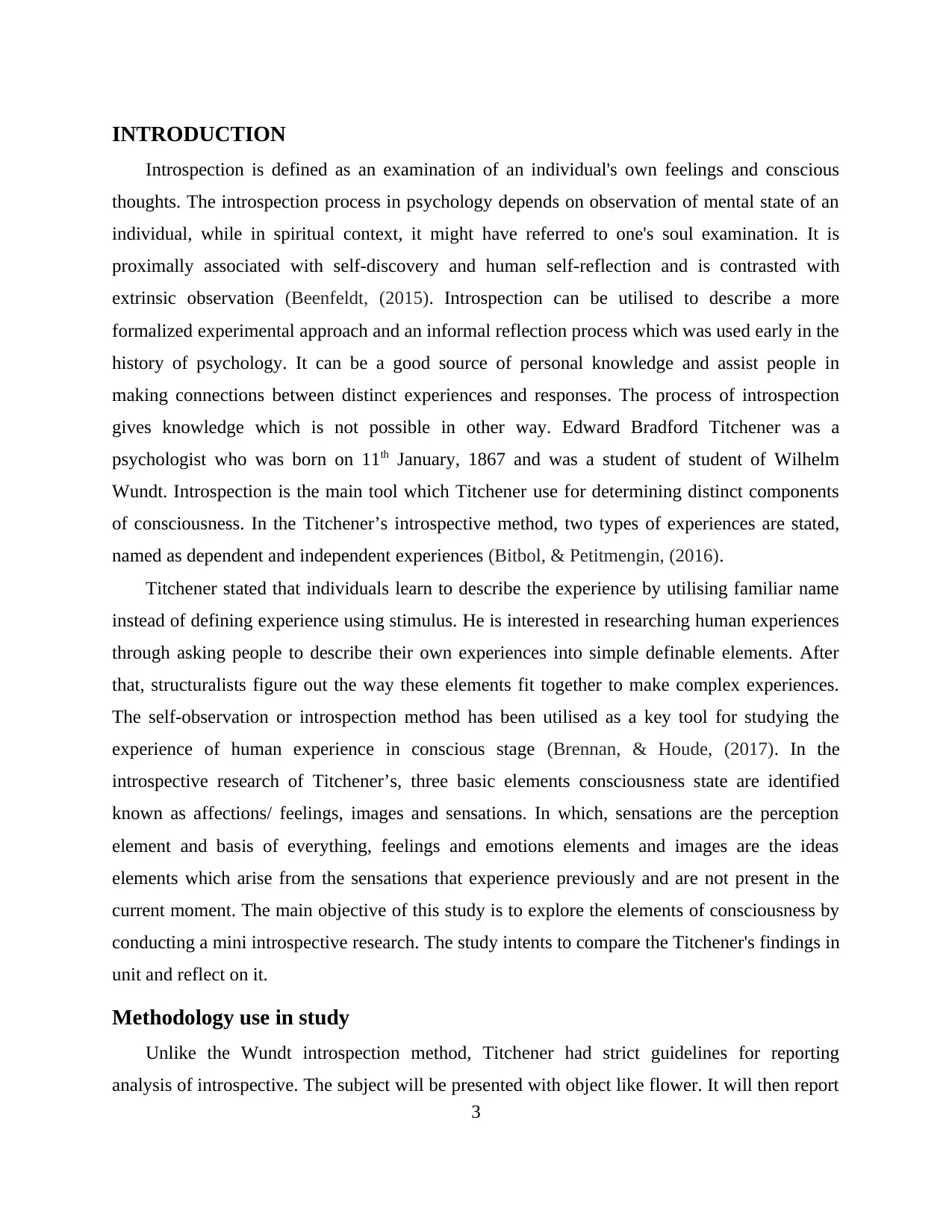
INTRODUCTION
Introspection is defined as an examination of an individual's own feelings and conscious
thoughts. The introspection process in psychology depends on observation of mental state of an
individual, while in spiritual context, it might have referred to one's soul examination. It is
proximally associated with self-discovery and human self-reflection and is contrasted with
extrinsic observation (Beenfeldt, (2015). Introspection can be utilised to describe a more
formalized experimental approach and an informal reflection process which was used early in the
history of psychology. It can be a good source of personal knowledge and assist people in
making connections between distinct experiences and responses. The process of introspection
gives knowledge which is not possible in other way. Edward Bradford Titchener was a
psychologist who was born on 11th January, 1867 and was a student of student of Wilhelm
Wundt. Introspection is the main tool which Titchener use for determining distinct components
of consciousness. In the Titchener’s introspective method, two types of experiences are stated,
named as dependent and independent experiences (Bitbol, & Petitmengin, (2016).
Titchener stated that individuals learn to describe the experience by utilising familiar name
instead of defining experience using stimulus. He is interested in researching human experiences
through asking people to describe their own experiences into simple definable elements. After
that, structuralists figure out the way these elements fit together to make complex experiences.
The self-observation or introspection method has been utilised as a key tool for studying the
experience of human experience in conscious stage (Brennan, & Houde, (2017). In the
introspective research of Titchener’s, three basic elements consciousness state are identified
known as affections/ feelings, images and sensations. In which, sensations are the perception
element and basis of everything, feelings and emotions elements and images are the ideas
elements which arise from the sensations that experience previously and are not present in the
current moment. The main objective of this study is to explore the elements of consciousness by
conducting a mini introspective research. The study intents to compare the Titchener's findings in
unit and reflect on it.
Methodology use in study
Unlike the Wundt introspection method, Titchener had strict guidelines for reporting
analysis of introspective. The subject will be presented with object like flower. It will then report
3
Introspection is defined as an examination of an individual's own feelings and conscious
thoughts. The introspection process in psychology depends on observation of mental state of an
individual, while in spiritual context, it might have referred to one's soul examination. It is
proximally associated with self-discovery and human self-reflection and is contrasted with
extrinsic observation (Beenfeldt, (2015). Introspection can be utilised to describe a more
formalized experimental approach and an informal reflection process which was used early in the
history of psychology. It can be a good source of personal knowledge and assist people in
making connections between distinct experiences and responses. The process of introspection
gives knowledge which is not possible in other way. Edward Bradford Titchener was a
psychologist who was born on 11th January, 1867 and was a student of student of Wilhelm
Wundt. Introspection is the main tool which Titchener use for determining distinct components
of consciousness. In the Titchener’s introspective method, two types of experiences are stated,
named as dependent and independent experiences (Bitbol, & Petitmengin, (2016).
Titchener stated that individuals learn to describe the experience by utilising familiar name
instead of defining experience using stimulus. He is interested in researching human experiences
through asking people to describe their own experiences into simple definable elements. After
that, structuralists figure out the way these elements fit together to make complex experiences.
The self-observation or introspection method has been utilised as a key tool for studying the
experience of human experience in conscious stage (Brennan, & Houde, (2017). In the
introspective research of Titchener’s, three basic elements consciousness state are identified
known as affections/ feelings, images and sensations. In which, sensations are the perception
element and basis of everything, feelings and emotions elements and images are the ideas
elements which arise from the sensations that experience previously and are not present in the
current moment. The main objective of this study is to explore the elements of consciousness by
conducting a mini introspective research. The study intents to compare the Titchener's findings in
unit and reflect on it.
Methodology use in study
Unlike the Wundt introspection method, Titchener had strict guidelines for reporting
analysis of introspective. The subject will be presented with object like flower. It will then report
3
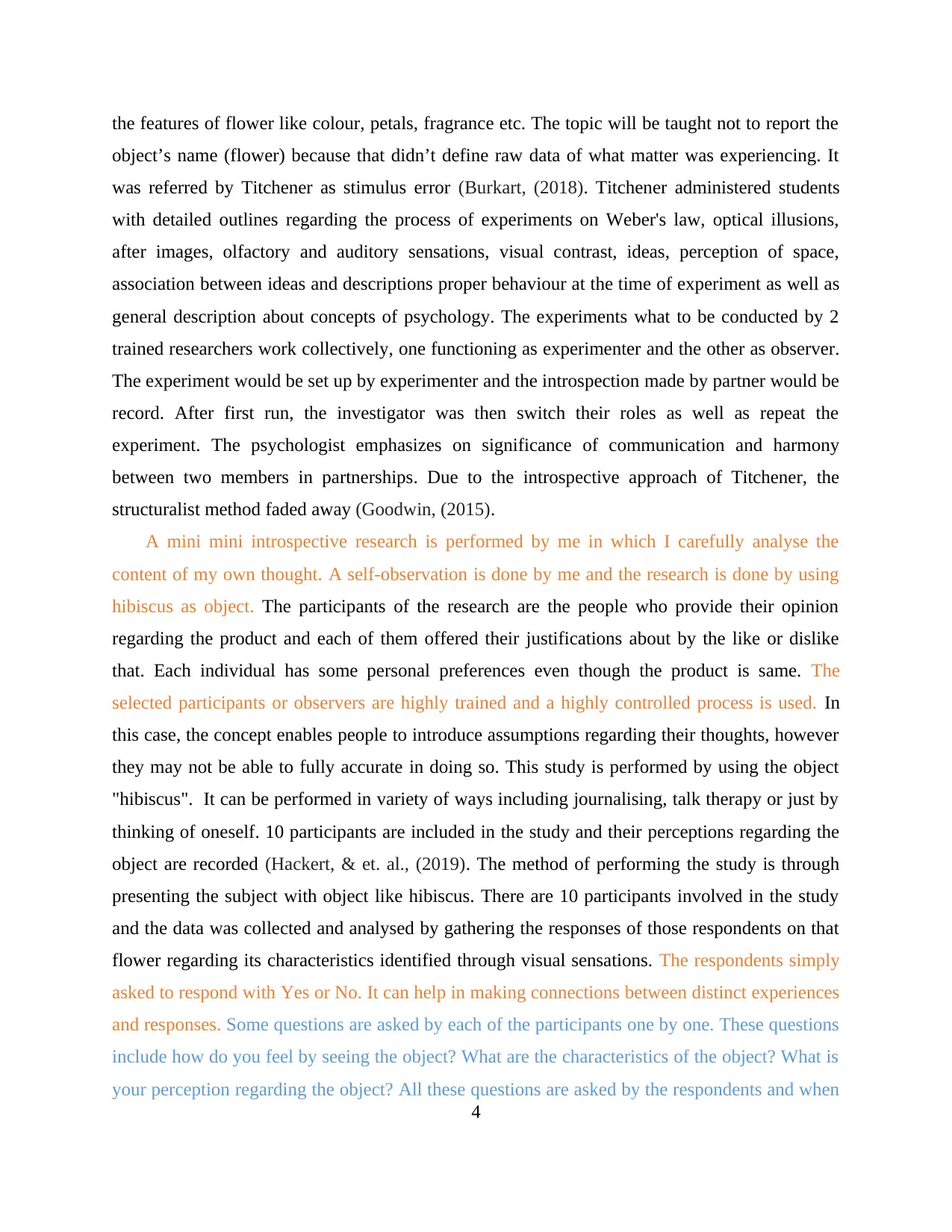
the features of flower like colour, petals, fragrance etc. The topic will be taught not to report the
object’s name (flower) because that didn’t define raw data of what matter was experiencing. It
was referred by Titchener as stimulus error (Burkart, (2018). Titchener administered students
with detailed outlines regarding the process of experiments on Weber's law, optical illusions,
after images, olfactory and auditory sensations, visual contrast, ideas, perception of space,
association between ideas and descriptions proper behaviour at the time of experiment as well as
general description about concepts of psychology. The experiments what to be conducted by 2
trained researchers work collectively, one functioning as experimenter and the other as observer.
The experiment would be set up by experimenter and the introspection made by partner would be
record. After first run, the investigator was then switch their roles as well as repeat the
experiment. The psychologist emphasizes on significance of communication and harmony
between two members in partnerships. Due to the introspective approach of Titchener, the
structuralist method faded away (Goodwin, (2015).
A mini mini introspective research is performed by me in which I carefully analyse the
content of my own thought. A self-observation is done by me and the research is done by using
hibiscus as object. The participants of the research are the people who provide their opinion
regarding the product and each of them offered their justifications about by the like or dislike
that. Each individual has some personal preferences even though the product is same. The
selected participants or observers are highly trained and a highly controlled process is used. In
this case, the concept enables people to introduce assumptions regarding their thoughts, however
they may not be able to fully accurate in doing so. This study is performed by using the object
"hibiscus". It can be performed in variety of ways including journalising, talk therapy or just by
thinking of oneself. 10 participants are included in the study and their perceptions regarding the
object are recorded (Hackert, & et. al., (2019). The method of performing the study is through
presenting the subject with object like hibiscus. There are 10 participants involved in the study
and the data was collected and analysed by gathering the responses of those respondents on that
flower regarding its characteristics identified through visual sensations. The respondents simply
asked to respond with Yes or No. It can help in making connections between distinct experiences
and responses. Some questions are asked by each of the participants one by one. These questions
include how do you feel by seeing the object? What are the characteristics of the object? What is
your perception regarding the object? All these questions are asked by the respondents and when
4
object’s name (flower) because that didn’t define raw data of what matter was experiencing. It
was referred by Titchener as stimulus error (Burkart, (2018). Titchener administered students
with detailed outlines regarding the process of experiments on Weber's law, optical illusions,
after images, olfactory and auditory sensations, visual contrast, ideas, perception of space,
association between ideas and descriptions proper behaviour at the time of experiment as well as
general description about concepts of psychology. The experiments what to be conducted by 2
trained researchers work collectively, one functioning as experimenter and the other as observer.
The experiment would be set up by experimenter and the introspection made by partner would be
record. After first run, the investigator was then switch their roles as well as repeat the
experiment. The psychologist emphasizes on significance of communication and harmony
between two members in partnerships. Due to the introspective approach of Titchener, the
structuralist method faded away (Goodwin, (2015).
A mini mini introspective research is performed by me in which I carefully analyse the
content of my own thought. A self-observation is done by me and the research is done by using
hibiscus as object. The participants of the research are the people who provide their opinion
regarding the product and each of them offered their justifications about by the like or dislike
that. Each individual has some personal preferences even though the product is same. The
selected participants or observers are highly trained and a highly controlled process is used. In
this case, the concept enables people to introduce assumptions regarding their thoughts, however
they may not be able to fully accurate in doing so. This study is performed by using the object
"hibiscus". It can be performed in variety of ways including journalising, talk therapy or just by
thinking of oneself. 10 participants are included in the study and their perceptions regarding the
object are recorded (Hackert, & et. al., (2019). The method of performing the study is through
presenting the subject with object like hibiscus. There are 10 participants involved in the study
and the data was collected and analysed by gathering the responses of those respondents on that
flower regarding its characteristics identified through visual sensations. The respondents simply
asked to respond with Yes or No. It can help in making connections between distinct experiences
and responses. Some questions are asked by each of the participants one by one. These questions
include how do you feel by seeing the object? What are the characteristics of the object? What is
your perception regarding the object? All these questions are asked by the respondents and when
4
Secure Best Marks with AI Grader
Need help grading? Try our AI Grader for instant feedback on your assignments.
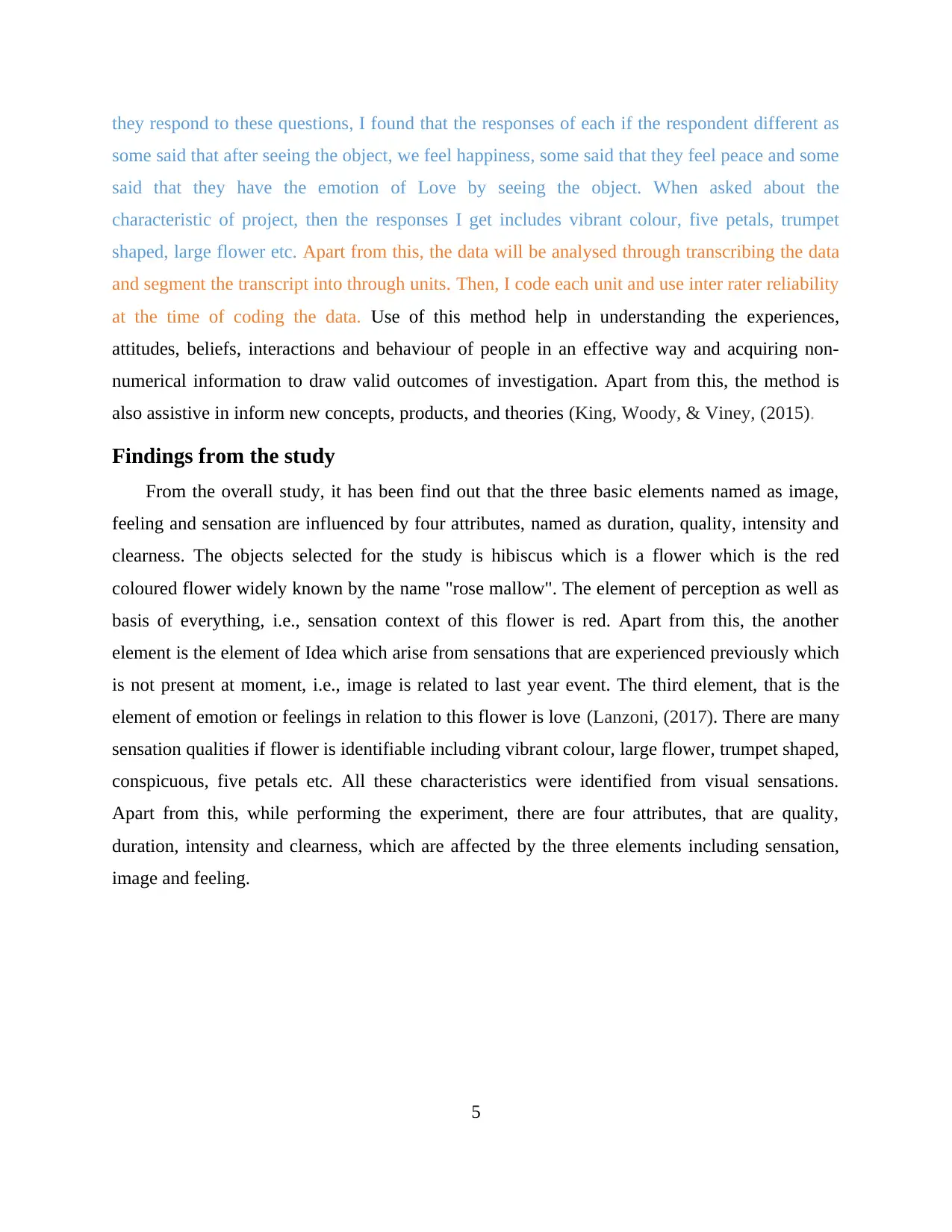
they respond to these questions, I found that the responses of each if the respondent different as
some said that after seeing the object, we feel happiness, some said that they feel peace and some
said that they have the emotion of Love by seeing the object. When asked about the
characteristic of project, then the responses I get includes vibrant colour, five petals, trumpet
shaped, large flower etc. Apart from this, the data will be analysed through transcribing the data
and segment the transcript into through units. Then, I code each unit and use inter rater reliability
at the time of coding the data. Use of this method help in understanding the experiences,
attitudes, beliefs, interactions and behaviour of people in an effective way and acquiring non-
numerical information to draw valid outcomes of investigation. Apart from this, the method is
also assistive in inform new concepts, products, and theories (King, Woody, & Viney, (2015).
Findings from the study
From the overall study, it has been find out that the three basic elements named as image,
feeling and sensation are influenced by four attributes, named as duration, quality, intensity and
clearness. The objects selected for the study is hibiscus which is a flower which is the red
coloured flower widely known by the name "rose mallow". The element of perception as well as
basis of everything, i.e., sensation context of this flower is red. Apart from this, the another
element is the element of Idea which arise from sensations that are experienced previously which
is not present at moment, i.e., image is related to last year event. The third element, that is the
element of emotion or feelings in relation to this flower is love (Lanzoni, (2017). There are many
sensation qualities if flower is identifiable including vibrant colour, large flower, trumpet shaped,
conspicuous, five petals etc. All these characteristics were identified from visual sensations.
Apart from this, while performing the experiment, there are four attributes, that are quality,
duration, intensity and clearness, which are affected by the three elements including sensation,
image and feeling.
5
some said that after seeing the object, we feel happiness, some said that they feel peace and some
said that they have the emotion of Love by seeing the object. When asked about the
characteristic of project, then the responses I get includes vibrant colour, five petals, trumpet
shaped, large flower etc. Apart from this, the data will be analysed through transcribing the data
and segment the transcript into through units. Then, I code each unit and use inter rater reliability
at the time of coding the data. Use of this method help in understanding the experiences,
attitudes, beliefs, interactions and behaviour of people in an effective way and acquiring non-
numerical information to draw valid outcomes of investigation. Apart from this, the method is
also assistive in inform new concepts, products, and theories (King, Woody, & Viney, (2015).
Findings from the study
From the overall study, it has been find out that the three basic elements named as image,
feeling and sensation are influenced by four attributes, named as duration, quality, intensity and
clearness. The objects selected for the study is hibiscus which is a flower which is the red
coloured flower widely known by the name "rose mallow". The element of perception as well as
basis of everything, i.e., sensation context of this flower is red. Apart from this, the another
element is the element of Idea which arise from sensations that are experienced previously which
is not present at moment, i.e., image is related to last year event. The third element, that is the
element of emotion or feelings in relation to this flower is love (Lanzoni, (2017). There are many
sensation qualities if flower is identifiable including vibrant colour, large flower, trumpet shaped,
conspicuous, five petals etc. All these characteristics were identified from visual sensations.
Apart from this, while performing the experiment, there are four attributes, that are quality,
duration, intensity and clearness, which are affected by the three elements including sensation,
image and feeling.
5
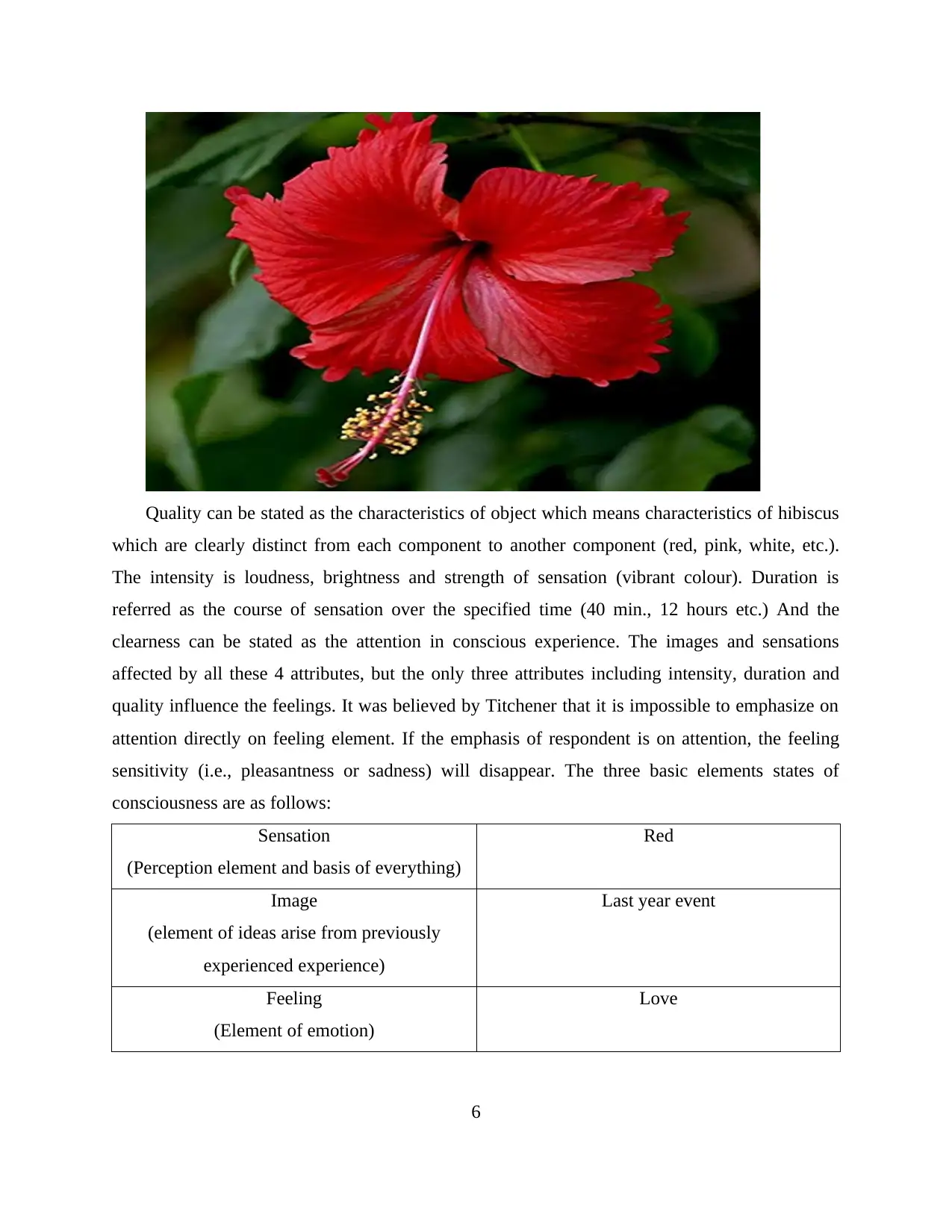
Quality can be stated as the characteristics of object which means characteristics of hibiscus
which are clearly distinct from each component to another component (red, pink, white, etc.).
The intensity is loudness, brightness and strength of sensation (vibrant colour). Duration is
referred as the course of sensation over the specified time (40 min., 12 hours etc.) And the
clearness can be stated as the attention in conscious experience. The images and sensations
affected by all these 4 attributes, but the only three attributes including intensity, duration and
quality influence the feelings. It was believed by Titchener that it is impossible to emphasize on
attention directly on feeling element. If the emphasis of respondent is on attention, the feeling
sensitivity (i.e., pleasantness or sadness) will disappear. The three basic elements states of
consciousness are as follows:
Sensation
(Perception element and basis of everything)
Red
Image
(element of ideas arise from previously
experienced experience)
Last year event
Feeling
(Element of emotion)
Love
6
which are clearly distinct from each component to another component (red, pink, white, etc.).
The intensity is loudness, brightness and strength of sensation (vibrant colour). Duration is
referred as the course of sensation over the specified time (40 min., 12 hours etc.) And the
clearness can be stated as the attention in conscious experience. The images and sensations
affected by all these 4 attributes, but the only three attributes including intensity, duration and
quality influence the feelings. It was believed by Titchener that it is impossible to emphasize on
attention directly on feeling element. If the emphasis of respondent is on attention, the feeling
sensitivity (i.e., pleasantness or sadness) will disappear. The three basic elements states of
consciousness are as follows:
Sensation
(Perception element and basis of everything)
Red
Image
(element of ideas arise from previously
experienced experience)
Last year event
Feeling
(Element of emotion)
Love
6
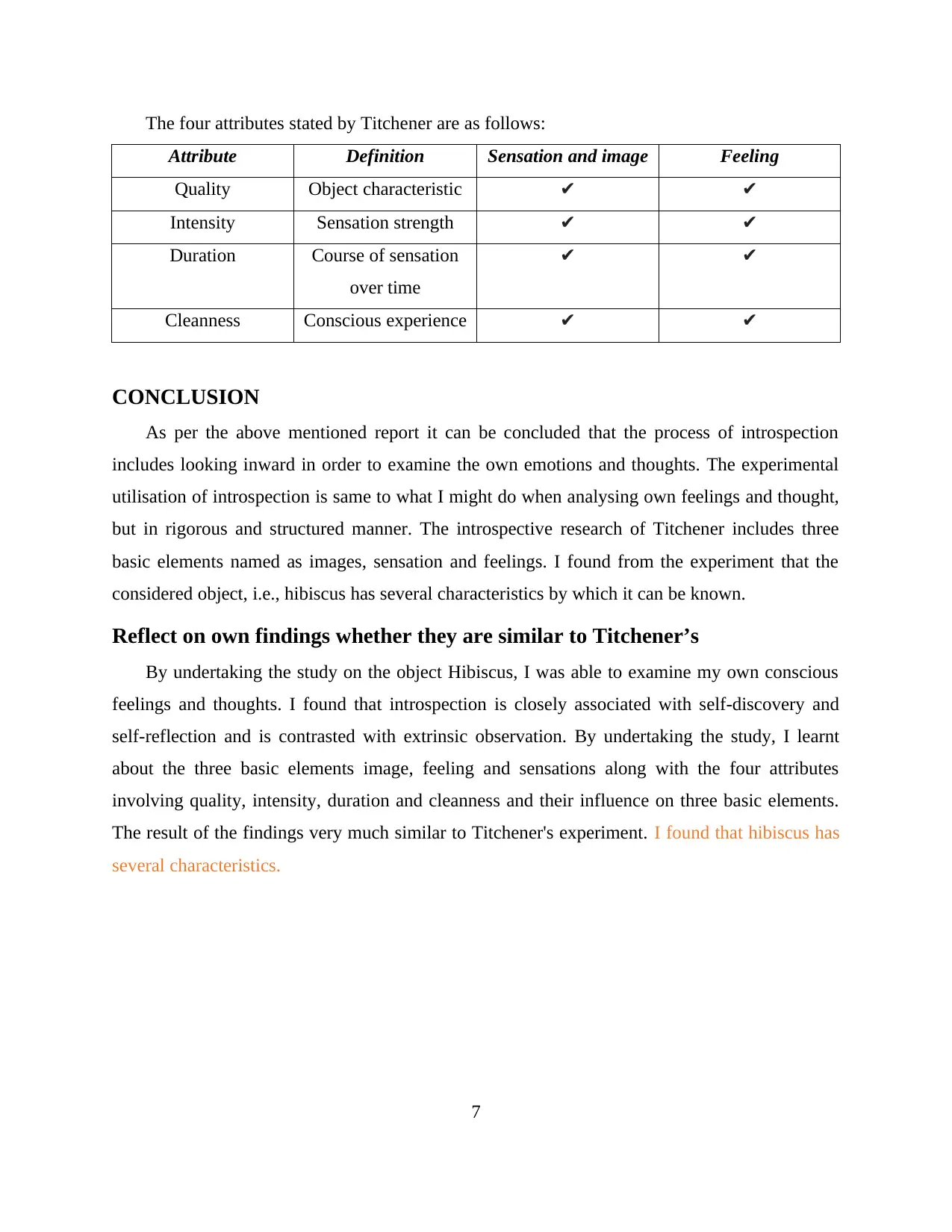
The four attributes stated by Titchener are as follows:
Attribute Definition Sensation and image Feeling
Quality Object characteristic ✔ ✔
Intensity Sensation strength ✔ ✔
Duration Course of sensation
over time
✔ ✔
Cleanness Conscious experience ✔ ✔
CONCLUSION
As per the above mentioned report it can be concluded that the process of introspection
includes looking inward in order to examine the own emotions and thoughts. The experimental
utilisation of introspection is same to what I might do when analysing own feelings and thought,
but in rigorous and structured manner. The introspective research of Titchener includes three
basic elements named as images, sensation and feelings. I found from the experiment that the
considered object, i.e., hibiscus has several characteristics by which it can be known.
Reflect on own findings whether they are similar to Titchener’s
By undertaking the study on the object Hibiscus, I was able to examine my own conscious
feelings and thoughts. I found that introspection is closely associated with self-discovery and
self-reflection and is contrasted with extrinsic observation. By undertaking the study, I learnt
about the three basic elements image, feeling and sensations along with the four attributes
involving quality, intensity, duration and cleanness and their influence on three basic elements.
The result of the findings very much similar to Titchener's experiment. I found that hibiscus has
several characteristics.
7
Attribute Definition Sensation and image Feeling
Quality Object characteristic ✔ ✔
Intensity Sensation strength ✔ ✔
Duration Course of sensation
over time
✔ ✔
Cleanness Conscious experience ✔ ✔
CONCLUSION
As per the above mentioned report it can be concluded that the process of introspection
includes looking inward in order to examine the own emotions and thoughts. The experimental
utilisation of introspection is same to what I might do when analysing own feelings and thought,
but in rigorous and structured manner. The introspective research of Titchener includes three
basic elements named as images, sensation and feelings. I found from the experiment that the
considered object, i.e., hibiscus has several characteristics by which it can be known.
Reflect on own findings whether they are similar to Titchener’s
By undertaking the study on the object Hibiscus, I was able to examine my own conscious
feelings and thoughts. I found that introspection is closely associated with self-discovery and
self-reflection and is contrasted with extrinsic observation. By undertaking the study, I learnt
about the three basic elements image, feeling and sensations along with the four attributes
involving quality, intensity, duration and cleanness and their influence on three basic elements.
The result of the findings very much similar to Titchener's experiment. I found that hibiscus has
several characteristics.
7
Paraphrase This Document
Need a fresh take? Get an instant paraphrase of this document with our AI Paraphraser
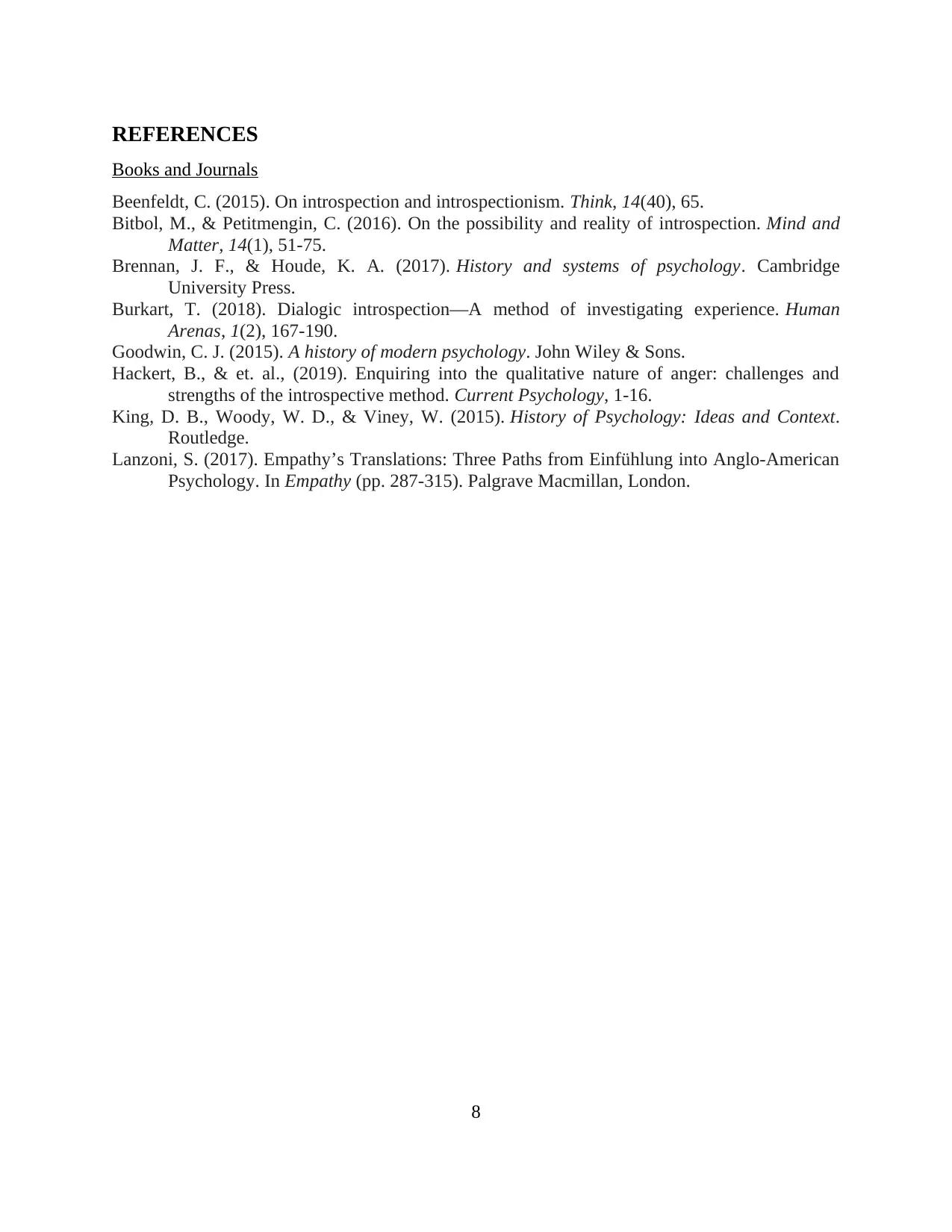
REFERENCES
Books and Journals
Beenfeldt, C. (2015). On introspection and introspectionism. Think, 14(40), 65.
Bitbol, M., & Petitmengin, C. (2016). On the possibility and reality of introspection. Mind and
Matter, 14(1), 51-75.
Brennan, J. F., & Houde, K. A. (2017). History and systems of psychology. Cambridge
University Press.
Burkart, T. (2018). Dialogic introspection—A method of investigating experience. Human
Arenas, 1(2), 167-190.
Goodwin, C. J. (2015). A history of modern psychology. John Wiley & Sons.
Hackert, B., & et. al., (2019). Enquiring into the qualitative nature of anger: challenges and
strengths of the introspective method. Current Psychology, 1-16.
King, D. B., Woody, W. D., & Viney, W. (2015). History of Psychology: Ideas and Context.
Routledge.
Lanzoni, S. (2017). Empathy’s Translations: Three Paths from Einfühlung into Anglo-American
Psychology. In Empathy (pp. 287-315). Palgrave Macmillan, London.
8
Books and Journals
Beenfeldt, C. (2015). On introspection and introspectionism. Think, 14(40), 65.
Bitbol, M., & Petitmengin, C. (2016). On the possibility and reality of introspection. Mind and
Matter, 14(1), 51-75.
Brennan, J. F., & Houde, K. A. (2017). History and systems of psychology. Cambridge
University Press.
Burkart, T. (2018). Dialogic introspection—A method of investigating experience. Human
Arenas, 1(2), 167-190.
Goodwin, C. J. (2015). A history of modern psychology. John Wiley & Sons.
Hackert, B., & et. al., (2019). Enquiring into the qualitative nature of anger: challenges and
strengths of the introspective method. Current Psychology, 1-16.
King, D. B., Woody, W. D., & Viney, W. (2015). History of Psychology: Ideas and Context.
Routledge.
Lanzoni, S. (2017). Empathy’s Translations: Three Paths from Einfühlung into Anglo-American
Psychology. In Empathy (pp. 287-315). Palgrave Macmillan, London.
8
1 out of 8
Your All-in-One AI-Powered Toolkit for Academic Success.
+13062052269
info@desklib.com
Available 24*7 on WhatsApp / Email
![[object Object]](/_next/static/media/star-bottom.7253800d.svg)
Unlock your academic potential
© 2024 | Zucol Services PVT LTD | All rights reserved.


